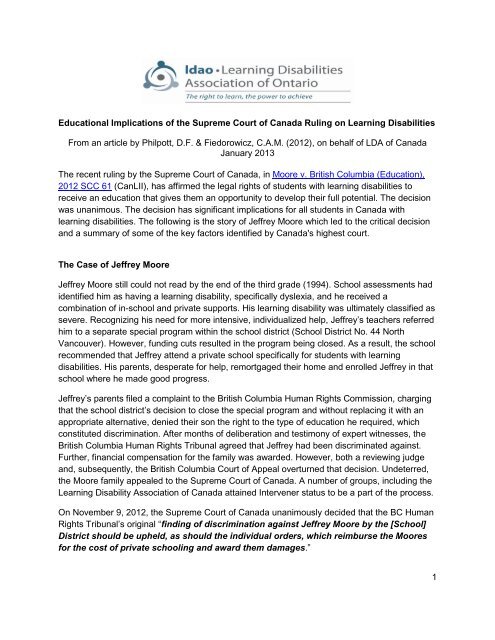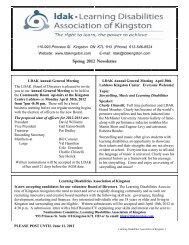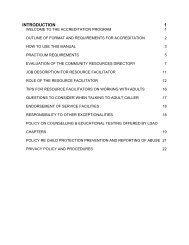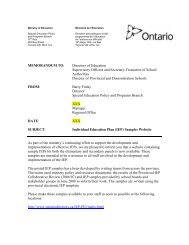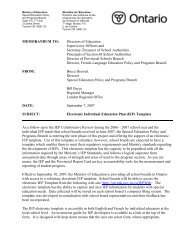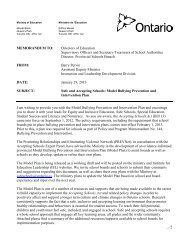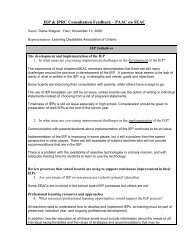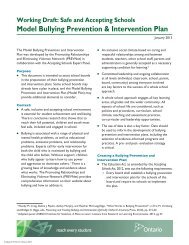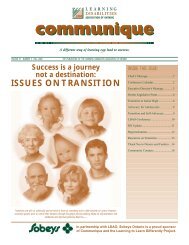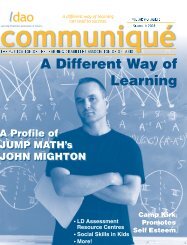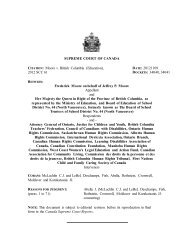Educational Implications of the Supreme Court of Canada Ruling on ...
Educational Implications of the Supreme Court of Canada Ruling on ...
Educational Implications of the Supreme Court of Canada Ruling on ...
You also want an ePaper? Increase the reach of your titles
YUMPU automatically turns print PDFs into web optimized ePapers that Google loves.
<str<strong>on</strong>g>Educati<strong>on</strong>al</str<strong>on</strong>g> <str<strong>on</strong>g>Implicati<strong>on</strong>s</str<strong>on</strong>g> <str<strong>on</strong>g>of</str<strong>on</strong>g> <str<strong>on</strong>g>the</str<strong>on</strong>g> <str<strong>on</strong>g>Supreme</str<strong>on</strong>g> <str<strong>on</strong>g>Court</str<strong>on</strong>g> <str<strong>on</strong>g>of</str<strong>on</strong>g> <str<strong>on</strong>g>Canada</str<strong>on</strong>g> <str<strong>on</strong>g>Ruling</str<strong>on</strong>g> <strong>on</strong> Learning Disabilities<br />
From an article by Philpott, D.F. & Fiedorowicz, C.A.M. (2012), <strong>on</strong> behalf <str<strong>on</strong>g>of</str<strong>on</strong>g> LDA <str<strong>on</strong>g>of</str<strong>on</strong>g> <str<strong>on</strong>g>Canada</str<strong>on</strong>g><br />
January 2013<br />
The recent ruling by <str<strong>on</strong>g>the</str<strong>on</strong>g> <str<strong>on</strong>g>Supreme</str<strong>on</strong>g> <str<strong>on</strong>g>Court</str<strong>on</strong>g> <str<strong>on</strong>g>of</str<strong>on</strong>g> <str<strong>on</strong>g>Canada</str<strong>on</strong>g>, in Moore v. British Columbia (Educati<strong>on</strong>),<br />
2012 SCC 61 (CanLII), has affirmed <str<strong>on</strong>g>the</str<strong>on</strong>g> legal rights <str<strong>on</strong>g>of</str<strong>on</strong>g> students with learning disabilities to<br />
receive an educati<strong>on</strong> that gives <str<strong>on</strong>g>the</str<strong>on</strong>g>m an opportunity to develop <str<strong>on</strong>g>the</str<strong>on</strong>g>ir full potential. The decisi<strong>on</strong><br />
was unanimous. The decisi<strong>on</strong> has significant implicati<strong>on</strong>s for all students in <str<strong>on</strong>g>Canada</str<strong>on</strong>g> with<br />
learning disabilities. The following is <str<strong>on</strong>g>the</str<strong>on</strong>g> story <str<strong>on</strong>g>of</str<strong>on</strong>g> Jeffrey Moore which led to <str<strong>on</strong>g>the</str<strong>on</strong>g> critical decisi<strong>on</strong><br />
and a summary <str<strong>on</strong>g>of</str<strong>on</strong>g> some <str<strong>on</strong>g>of</str<strong>on</strong>g> <str<strong>on</strong>g>the</str<strong>on</strong>g> key factors identified by <str<strong>on</strong>g>Canada</str<strong>on</strong>g>'s highest court.<br />
The Case <str<strong>on</strong>g>of</str<strong>on</strong>g> Jeffrey Moore<br />
Jeffrey Moore still could not read by <str<strong>on</strong>g>the</str<strong>on</strong>g> end <str<strong>on</strong>g>of</str<strong>on</strong>g> <str<strong>on</strong>g>the</str<strong>on</strong>g> third grade (1994). School assessments had<br />
identified him as having a learning disability, specifically dyslexia, and he received a<br />
combinati<strong>on</strong> <str<strong>on</strong>g>of</str<strong>on</strong>g> in-school and private supports. His learning disability was ultimately classified as<br />
severe. Recognizing his need for more intensive, individualized help, Jeffrey’s teachers referred<br />
him to a separate special program within <str<strong>on</strong>g>the</str<strong>on</strong>g> school district (School District No. 44 North<br />
Vancouver). However, funding cuts resulted in <str<strong>on</strong>g>the</str<strong>on</strong>g> program being closed. As a result, <str<strong>on</strong>g>the</str<strong>on</strong>g> school<br />
recommended that Jeffrey attend a private school specifically for students with learning<br />
disabilities. His parents, desperate for help, remortgaged <str<strong>on</strong>g>the</str<strong>on</strong>g>ir home and enrolled Jeffrey in that<br />
school where he made good progress.<br />
Jeffrey’s parents filed a complaint to <str<strong>on</strong>g>the</str<strong>on</strong>g> British Columbia Human Rights Commissi<strong>on</strong>, charging<br />
that <str<strong>on</strong>g>the</str<strong>on</strong>g> school district’s decisi<strong>on</strong> to close <str<strong>on</strong>g>the</str<strong>on</strong>g> special program and without replacing it with an<br />
appropriate alternative, denied <str<strong>on</strong>g>the</str<strong>on</strong>g>ir s<strong>on</strong> <str<strong>on</strong>g>the</str<strong>on</strong>g> right to <str<strong>on</strong>g>the</str<strong>on</strong>g> type <str<strong>on</strong>g>of</str<strong>on</strong>g> educati<strong>on</strong> he required, which<br />
c<strong>on</strong>stituted discriminati<strong>on</strong>. After m<strong>on</strong>ths <str<strong>on</strong>g>of</str<strong>on</strong>g> deliberati<strong>on</strong> and testim<strong>on</strong>y <str<strong>on</strong>g>of</str<strong>on</strong>g> expert witnesses, <str<strong>on</strong>g>the</str<strong>on</strong>g><br />
British Columbia Human Rights Tribunal agreed that Jeffrey had been discriminated against.<br />
Fur<str<strong>on</strong>g>the</str<strong>on</strong>g>r, financial compensati<strong>on</strong> for <str<strong>on</strong>g>the</str<strong>on</strong>g> family was awarded. However, both a reviewing judge<br />
and, subsequently, <str<strong>on</strong>g>the</str<strong>on</strong>g> British Columbia <str<strong>on</strong>g>Court</str<strong>on</strong>g> <str<strong>on</strong>g>of</str<strong>on</strong>g> Appeal overturned that decisi<strong>on</strong>. Undeterred,<br />
<str<strong>on</strong>g>the</str<strong>on</strong>g> Moore family appealed to <str<strong>on</strong>g>the</str<strong>on</strong>g> <str<strong>on</strong>g>Supreme</str<strong>on</strong>g> <str<strong>on</strong>g>Court</str<strong>on</strong>g> <str<strong>on</strong>g>of</str<strong>on</strong>g> <str<strong>on</strong>g>Canada</str<strong>on</strong>g>. A number <str<strong>on</strong>g>of</str<strong>on</strong>g> groups, including <str<strong>on</strong>g>the</str<strong>on</strong>g><br />
Learning Disability Associati<strong>on</strong> <str<strong>on</strong>g>of</str<strong>on</strong>g> <str<strong>on</strong>g>Canada</str<strong>on</strong>g> attained Intervener status to be a part <str<strong>on</strong>g>of</str<strong>on</strong>g> <str<strong>on</strong>g>the</str<strong>on</strong>g> process.<br />
On November 9, 2012, <str<strong>on</strong>g>the</str<strong>on</strong>g> <str<strong>on</strong>g>Supreme</str<strong>on</strong>g> <str<strong>on</strong>g>Court</str<strong>on</strong>g> <str<strong>on</strong>g>of</str<strong>on</strong>g> <str<strong>on</strong>g>Canada</str<strong>on</strong>g> unanimously decided that <str<strong>on</strong>g>the</str<strong>on</strong>g> BC Human<br />
Rights Tribunal’s original “finding <str<strong>on</strong>g>of</str<strong>on</strong>g> discriminati<strong>on</strong> against Jeffrey Moore by <str<strong>on</strong>g>the</str<strong>on</strong>g> [School]<br />
District should be upheld, as should <str<strong>on</strong>g>the</str<strong>on</strong>g> individual orders, which reimburse <str<strong>on</strong>g>the</str<strong>on</strong>g> Moores<br />
for <str<strong>on</strong>g>the</str<strong>on</strong>g> cost <str<strong>on</strong>g>of</str<strong>on</strong>g> private schooling and award <str<strong>on</strong>g>the</str<strong>on</strong>g>m damages.”<br />
1
The <str<strong>on</strong>g>Supreme</str<strong>on</strong>g> <str<strong>on</strong>g>Court</str<strong>on</strong>g> made an articulate and powerful statement that: “…adequate special<br />
educati<strong>on</strong>, <str<strong>on</strong>g>the</str<strong>on</strong>g>refore, is not a dispensable luxury. For those with severe learning<br />
disabilities, it is <str<strong>on</strong>g>the</str<strong>on</strong>g> ramp that provides access to <str<strong>on</strong>g>the</str<strong>on</strong>g> statutory commitment to educati<strong>on</strong><br />
made to all children…”.<br />
Summary and implicati<strong>on</strong>s <str<strong>on</strong>g>of</str<strong>on</strong>g> some <str<strong>on</strong>g>of</str<strong>on</strong>g> <str<strong>on</strong>g>the</str<strong>on</strong>g> key factors identified by <str<strong>on</strong>g>the</str<strong>on</strong>g> <str<strong>on</strong>g>Supreme</str<strong>on</strong>g> <str<strong>on</strong>g>Court</str<strong>on</strong>g><br />
The <str<strong>on</strong>g>Supreme</str<strong>on</strong>g> <str<strong>on</strong>g>Court</str<strong>on</strong>g> <str<strong>on</strong>g>of</str<strong>on</strong>g> <str<strong>on</strong>g>Canada</str<strong>on</strong>g> validated <str<strong>on</strong>g>the</str<strong>on</strong>g> positi<strong>on</strong> l<strong>on</strong>g held by learning disability<br />
associati<strong>on</strong>s across <str<strong>on</strong>g>Canada</str<strong>on</strong>g> in <str<strong>on</strong>g>the</str<strong>on</strong>g>ir support for <str<strong>on</strong>g>the</str<strong>on</strong>g> right <str<strong>on</strong>g>of</str<strong>on</strong>g> all students with learning<br />
disabilities to adequate special educati<strong>on</strong> programs and services, including intensive<br />
evidence-based interventi<strong>on</strong>s for those who need <str<strong>on</strong>g>the</str<strong>on</strong>g>m. The Learning Disabilities<br />
Associati<strong>on</strong> <str<strong>on</strong>g>of</str<strong>on</strong>g> Ontario has stated this positi<strong>on</strong> in its resp<strong>on</strong>ses to Educati<strong>on</strong> for All and Learning<br />
for All.<br />
The <str<strong>on</strong>g>Supreme</str<strong>on</strong>g> <str<strong>on</strong>g>Court</str<strong>on</strong>g> ruling stated that, “…discriminati<strong>on</strong> was made out based <strong>on</strong> <str<strong>on</strong>g>the</str<strong>on</strong>g><br />
insufficiently intensive remediati<strong>on</strong> provided by <str<strong>on</strong>g>the</str<strong>on</strong>g> District for Jeffrey’s learning<br />
disability in order for him to get access to <str<strong>on</strong>g>the</str<strong>on</strong>g> educati<strong>on</strong> he was entitled to.” According to<br />
Philpott and Fiedorowicz, <str<strong>on</strong>g>the</str<strong>on</strong>g> ruling means that educators have an obligati<strong>on</strong> to provide<br />
individualized programs for individual needs based <strong>on</strong> appropriate assessment.<br />
<str<strong>on</strong>g>Implicati<strong>on</strong>s</str<strong>on</strong>g> for learning disabilities as a disability<br />
The <str<strong>on</strong>g>Supreme</str<strong>on</strong>g> <str<strong>on</strong>g>Court</str<strong>on</strong>g> ruling stated that “There is no dispute that Jeffrey’s dyslexia is a<br />
disability. There is equally no questi<strong>on</strong> that any adverse impact he suffered is related to<br />
his disability.” According to Philpott and Fiedorowicz this language <str<strong>on</strong>g>of</str<strong>on</strong>g> <str<strong>on</strong>g>the</str<strong>on</strong>g> ruling legally<br />
secures both <str<strong>on</strong>g>the</str<strong>on</strong>g> diagnosis <str<strong>on</strong>g>of</str<strong>on</strong>g> Learning Disabilities as a disability under <str<strong>on</strong>g>the</str<strong>on</strong>g> law (including<br />
dyslexia) and its potential to inflict harm, if unattended. They see <str<strong>on</strong>g>the</str<strong>on</strong>g> ruling as supporting <str<strong>on</strong>g>the</str<strong>on</strong>g><br />
positi<strong>on</strong> that expeditious identificati<strong>on</strong> and provisi<strong>on</strong> <str<strong>on</strong>g>of</str<strong>on</strong>g> individualized interventi<strong>on</strong>s in <str<strong>on</strong>g>the</str<strong>on</strong>g> most<br />
enabling envir<strong>on</strong>ment are critical for students with learning disabilities.<br />
<str<strong>on</strong>g>Implicati<strong>on</strong>s</str<strong>on</strong>g> for special educati<strong>on</strong> and inclusive educati<strong>on</strong><br />
The <str<strong>on</strong>g>Supreme</str<strong>on</strong>g> <str<strong>on</strong>g>Court</str<strong>on</strong>g> ruling stated that “…for students with learning disabilities like Jeffrey’s,<br />
Special Educati<strong>on</strong> is not <str<strong>on</strong>g>the</str<strong>on</strong>g> service, it is <str<strong>on</strong>g>the</str<strong>on</strong>g> means by which those students get<br />
meaningful access to <str<strong>on</strong>g>the</str<strong>on</strong>g> general educati<strong>on</strong>…”. The court agreed with <str<strong>on</strong>g>the</str<strong>on</strong>g> British Columbia<br />
Human Rights Tribunal in stating that “…a range <str<strong>on</strong>g>of</str<strong>on</strong>g> services was necessary for <str<strong>on</strong>g>the</str<strong>on</strong>g>se<br />
students…” According to Philpott and Fiedorowicz <str<strong>on</strong>g>the</str<strong>on</strong>g> ruling is a clear and unequivocal<br />
rec<strong>on</strong>firmati<strong>on</strong> that a cascade or c<strong>on</strong>tinuum <str<strong>on</strong>g>of</str<strong>on</strong>g> interventi<strong>on</strong>s for a range <str<strong>on</strong>g>of</str<strong>on</strong>g> needs is not a<br />
“luxury” and indeed is <str<strong>on</strong>g>the</str<strong>on</strong>g> standard that must be applied. This is in c<strong>on</strong>trast to a comm<strong>on</strong><br />
interpretati<strong>on</strong> <str<strong>on</strong>g>of</str<strong>on</strong>g> inclusive educati<strong>on</strong> in which placement in <str<strong>on</strong>g>the</str<strong>on</strong>g> regular class is <str<strong>on</strong>g>the</str<strong>on</strong>g> preferred<br />
opti<strong>on</strong> for all students.<br />
2
<str<strong>on</strong>g>Implicati<strong>on</strong>s</str<strong>on</strong>g> <str<strong>on</strong>g>of</str<strong>on</strong>g> “meaningful access”<br />
The <str<strong>on</strong>g>Supreme</str<strong>on</strong>g> <str<strong>on</strong>g>Court</str<strong>on</strong>g> ruling stated that “Jeffrey required intensive remediati<strong>on</strong> in order to<br />
have meaningful access to educati<strong>on</strong>”. The ruling addressed both <str<strong>on</strong>g>the</str<strong>on</strong>g> importance <str<strong>on</strong>g>of</str<strong>on</strong>g> remedial<br />
services and <str<strong>on</strong>g>the</str<strong>on</strong>g> equality <str<strong>on</strong>g>of</str<strong>on</strong>g> opportunity for individual students in order to access and master <str<strong>on</strong>g>the</str<strong>on</strong>g><br />
curriculum at <str<strong>on</strong>g>the</str<strong>on</strong>g>ir individual levels. While students have equal access to a general educati<strong>on</strong>, in<br />
order to have meaningful access, i.e. an opportunity to achieve within that curriculum, <str<strong>on</strong>g>the</str<strong>on</strong>g>ir<br />
needs must be c<strong>on</strong>sidered <strong>on</strong> an individual basis.<br />
Fur<str<strong>on</strong>g>the</str<strong>on</strong>g>rmore, <str<strong>on</strong>g>the</str<strong>on</strong>g> <str<strong>on</strong>g>Supreme</str<strong>on</strong>g> <str<strong>on</strong>g>Court</str<strong>on</strong>g> ruling states that program decisi<strong>on</strong>s must be based <strong>on</strong> <str<strong>on</strong>g>the</str<strong>on</strong>g><br />
subjective, child-centered “individual needs” <str<strong>on</strong>g>of</str<strong>on</strong>g> each student and that equal treatment may be<br />
discriminatory if it violates <str<strong>on</strong>g>the</str<strong>on</strong>g>ir individual rights. The <str<strong>on</strong>g>Supreme</str<strong>on</strong>g> <str<strong>on</strong>g>Court</str<strong>on</strong>g> rejected <str<strong>on</strong>g>the</str<strong>on</strong>g> argument that<br />
<str<strong>on</strong>g>the</str<strong>on</strong>g> needs <str<strong>on</strong>g>of</str<strong>on</strong>g> <strong>on</strong>e special needs student should be compared with <str<strong>on</strong>g>the</str<strong>on</strong>g> needs <str<strong>on</strong>g>of</str<strong>on</strong>g> o<str<strong>on</strong>g>the</str<strong>on</strong>g>r special<br />
needs students. According to Philpott and Fiedorowicz, <str<strong>on</strong>g>the</str<strong>on</strong>g> ruling counteracts <str<strong>on</strong>g>the</str<strong>on</strong>g> perspective<br />
that <strong>on</strong>e placement opti<strong>on</strong> or <strong>on</strong>e program model is best for all students, or even similar<br />
students.<br />
<str<strong>on</strong>g>Implicati<strong>on</strong>s</str<strong>on</strong>g> for school board funding cuts<br />
Regarding to <str<strong>on</strong>g>the</str<strong>on</strong>g> BC school district’s decisi<strong>on</strong> to close <str<strong>on</strong>g>the</str<strong>on</strong>g> special program due to budget<br />
cutbacks, without replacing it with an appropriate alternative, <str<strong>on</strong>g>the</str<strong>on</strong>g> <str<strong>on</strong>g>Supreme</str<strong>on</strong>g> <str<strong>on</strong>g>Court</str<strong>on</strong>g> c<strong>on</strong>cluded that<br />
“…cuts were disproporti<strong>on</strong>ably made to special needs programs…” and “… that <str<strong>on</strong>g>the</str<strong>on</strong>g><br />
district did so without knowing how <str<strong>on</strong>g>the</str<strong>on</strong>g> needs <str<strong>on</strong>g>of</str<strong>on</strong>g> students like Jeffrey would be<br />
addressed…”. “Accommodati<strong>on</strong> is not a questi<strong>on</strong> <str<strong>on</strong>g>of</str<strong>on</strong>g> more efficiency” and a budget cut<br />
could well result in a disproporti<strong>on</strong>ate and <str<strong>on</strong>g>the</str<strong>on</strong>g>refore unfair impact <strong>on</strong> some students. Philpott<br />
and Fiedorowicz state that school districts and school boards across <str<strong>on</strong>g>the</str<strong>on</strong>g> country will need to<br />
take this ruling into account when c<strong>on</strong>sidering cutting programs for students with learning<br />
disabilities.<br />
Summary <str<strong>on</strong>g>of</str<strong>on</strong>g> implicati<strong>on</strong>s<br />
Philpott and Fiedorowicz point out that <str<strong>on</strong>g>the</str<strong>on</strong>g> <str<strong>on</strong>g>Supreme</str<strong>on</strong>g> <str<strong>on</strong>g>Court</str<strong>on</strong>g> <str<strong>on</strong>g>of</str<strong>on</strong>g> <str<strong>on</strong>g>Canada</str<strong>on</strong>g> is <str<strong>on</strong>g>the</str<strong>on</strong>g> ultimate legal<br />
decisi<strong>on</strong> maker in <str<strong>on</strong>g>Canada</str<strong>on</strong>g> and its rulings impact public policy and practice. They summarize<br />
that <str<strong>on</strong>g>the</str<strong>on</strong>g> Jeffrey Moore decisi<strong>on</strong>:<br />
<br />
challenges those involved in <str<strong>on</strong>g>the</str<strong>on</strong>g> provisi<strong>on</strong> <str<strong>on</strong>g>of</str<strong>on</strong>g> educati<strong>on</strong> to recalibrate both <str<strong>on</strong>g>the</str<strong>on</strong>g>ir<br />
understanding <str<strong>on</strong>g>of</str<strong>on</strong>g> <str<strong>on</strong>g>the</str<strong>on</strong>g> individualized needs <str<strong>on</strong>g>of</str<strong>on</strong>g> students with learning disabilities and how best<br />
to provide services that give <str<strong>on</strong>g>the</str<strong>on</strong>g>m meaningful access to an educati<strong>on</strong> that maximizes <str<strong>on</strong>g>the</str<strong>on</strong>g>ir<br />
potential.<br />
<br />
challenges teachers to be increasingly diligent in <str<strong>on</strong>g>the</str<strong>on</strong>g>ir pr<str<strong>on</strong>g>of</str<strong>on</strong>g>essi<strong>on</strong>al practice to identify and<br />
resp<strong>on</strong>d.<br />
3
challenges psychologists to be thorough and accurate in <str<strong>on</strong>g>the</str<strong>on</strong>g>ir assessments, diagnosis and<br />
recommendati<strong>on</strong>s for interventi<strong>on</strong>s.<br />
challenges decisi<strong>on</strong> makers to be resp<strong>on</strong>sible and accountable for <str<strong>on</strong>g>the</str<strong>on</strong>g> outcome <str<strong>on</strong>g>of</str<strong>on</strong>g> funding<br />
decisi<strong>on</strong>s. It c<strong>on</strong>firms <str<strong>on</strong>g>the</str<strong>on</strong>g> court’s l<strong>on</strong>g held stand that <str<strong>on</strong>g>the</str<strong>on</strong>g> individual needs <str<strong>on</strong>g>of</str<strong>on</strong>g> students<br />
require individual planning and that a c<strong>on</strong>tinuum <str<strong>on</strong>g>of</str<strong>on</strong>g> services is required.<br />
POLICY STATEMENT ON EDUCATIONAL INCLUSION FOR<br />
STUDENTS WITH LEARNING DISABILITIES<br />
The following policy statement <str<strong>on</strong>g>of</str<strong>on</strong>g> <str<strong>on</strong>g>the</str<strong>on</strong>g> Learning Disabilities Associati<strong>on</strong> <str<strong>on</strong>g>of</str<strong>on</strong>g> <str<strong>on</strong>g>Canada</str<strong>on</strong>g> (LDAC) was<br />
adopted by <str<strong>on</strong>g>the</str<strong>on</strong>g> Board <str<strong>on</strong>g>of</str<strong>on</strong>g> Directors <str<strong>on</strong>g>of</str<strong>on</strong>g> <str<strong>on</strong>g>the</str<strong>on</strong>g> Learning Disabilities Associati<strong>on</strong> <str<strong>on</strong>g>of</str<strong>on</strong>g> Ontario (LDAO), as<br />
recommended by <str<strong>on</strong>g>the</str<strong>on</strong>g> LDAO Legislati<strong>on</strong> and Policy Committee, <strong>on</strong> November 17, 2008.<br />
Learning Disabilities Associati<strong>on</strong> <str<strong>on</strong>g>of</str<strong>on</strong>g> <str<strong>on</strong>g>Canada</str<strong>on</strong>g> (LDAC) Policy Statement <strong>on</strong> <str<strong>on</strong>g>Educati<strong>on</strong>al</str<strong>on</strong>g><br />
Inclusi<strong>on</strong> for Students with Learning Disabilities (presented to <str<strong>on</strong>g>the</str<strong>on</strong>g> LDAC Executive<br />
Committee in February 2005, <str<strong>on</strong>g>the</str<strong>on</strong>g> LDAC Board <str<strong>on</strong>g>of</str<strong>on</strong>g> Directors in June 2005 and ratified <strong>on</strong><br />
November 26, 2005).<br />
STATEMENT<br />
The Learning Disabilities Associati<strong>on</strong> <str<strong>on</strong>g>of</str<strong>on</strong>g> <str<strong>on</strong>g>Canada</str<strong>on</strong>g> (LDAC) does not support full educati<strong>on</strong>al<br />
inclusi<strong>on</strong> or any policies that mandate <str<strong>on</strong>g>the</str<strong>on</strong>g> same placement, instructi<strong>on</strong>, or treatment <str<strong>on</strong>g>of</str<strong>on</strong>g> all<br />
students with learning disabilities or <str<strong>on</strong>g>the</str<strong>on</strong>g> idea that all students with learning disabilities must be<br />
served <strong>on</strong>ly in regular educati<strong>on</strong> classrooms at <str<strong>on</strong>g>the</str<strong>on</strong>g> exclusi<strong>on</strong> <str<strong>on</strong>g>of</str<strong>on</strong>g> all o<str<strong>on</strong>g>the</str<strong>on</strong>g>r special educati<strong>on</strong><br />
placement opti<strong>on</strong>s. LDAC believes that full inclusi<strong>on</strong>, when defined this way, violates <str<strong>on</strong>g>the</str<strong>on</strong>g> rights<br />
<str<strong>on</strong>g>of</str<strong>on</strong>g> parents and students with disabilities guaranteed by <str<strong>on</strong>g>the</str<strong>on</strong>g> Charter <str<strong>on</strong>g>of</str<strong>on</strong>g> Rights and Freedom and<br />
Human Rights Codes which guarantee educati<strong>on</strong> equality and freedom from discriminati<strong>on</strong> and<br />
rejects <str<strong>on</strong>g>the</str<strong>on</strong>g> arbitrary placement <str<strong>on</strong>g>of</str<strong>on</strong>g> all students in any <strong>on</strong>e setting.<br />
LDAC supports <str<strong>on</strong>g>the</str<strong>on</strong>g> availability <str<strong>on</strong>g>of</str<strong>on</strong>g> a c<strong>on</strong>tinuum <str<strong>on</strong>g>of</str<strong>on</strong>g> educati<strong>on</strong> services as prescribed in an<br />
individual educati<strong>on</strong>al plan for each student with learning disabilities to ensure success and<br />
must be flexible enough to meet <str<strong>on</strong>g>the</str<strong>on</strong>g> changing needs <str<strong>on</strong>g>of</str<strong>on</strong>g> students with learning disabilities by:<br />
1) Providing a range <str<strong>on</strong>g>of</str<strong>on</strong>g> opti<strong>on</strong>s and services and diverse learning envir<strong>on</strong>ments (placements) to<br />
meet <str<strong>on</strong>g>the</str<strong>on</strong>g> specific needs <str<strong>on</strong>g>of</str<strong>on</strong>g> each student;<br />
2) Providing <str<strong>on</strong>g>the</str<strong>on</strong>g> most enabling envir<strong>on</strong>ment for that student that will effectively meet <str<strong>on</strong>g>the</str<strong>on</strong>g><br />
student’s best interests socially, emoti<strong>on</strong>ally, behaviourally, physically and educati<strong>on</strong>ally; and,<br />
4
3) Focus <strong>on</strong> what is in <str<strong>on</strong>g>the</str<strong>on</strong>g> best interest <str<strong>on</strong>g>of</str<strong>on</strong>g> <str<strong>on</strong>g>the</str<strong>on</strong>g> student and, in that c<strong>on</strong>text, c<strong>on</strong>sider all <str<strong>on</strong>g>the</str<strong>on</strong>g> needs<br />
<str<strong>on</strong>g>of</str<strong>on</strong>g> <str<strong>on</strong>g>the</str<strong>on</strong>g> student as expressed by <str<strong>on</strong>g>the</str<strong>on</strong>g> student and his/her parents and that <str<strong>on</strong>g>of</str<strong>on</strong>g> <str<strong>on</strong>g>the</str<strong>on</strong>g>ir c<strong>on</strong>sulting<br />
pr<str<strong>on</strong>g>of</str<strong>on</strong>g>essi<strong>on</strong>als.<br />
RATIONALE<br />
Because each student with learning disabilities has unique needs, an individualized educati<strong>on</strong><br />
plan and placement must be tailored <strong>on</strong> individual strengths and needs. For <strong>on</strong>e student, <str<strong>on</strong>g>the</str<strong>on</strong>g><br />
plan may be provided in <str<strong>on</strong>g>the</str<strong>on</strong>g> regular classroom yet for ano<str<strong>on</strong>g>the</str<strong>on</strong>g>r student, <str<strong>on</strong>g>the</str<strong>on</strong>g> regular classroom<br />
may be an inappropriate placement and may need alternative instructi<strong>on</strong>al envir<strong>on</strong>ments,<br />
teaching strategies, and/or materials that cannot or will not be provided within <str<strong>on</strong>g>the</str<strong>on</strong>g> c<strong>on</strong>text <str<strong>on</strong>g>of</str<strong>on</strong>g> <str<strong>on</strong>g>the</str<strong>on</strong>g><br />
regular classroom envir<strong>on</strong>ment. The severity and nature <str<strong>on</strong>g>of</str<strong>on</strong>g> <str<strong>on</strong>g>the</str<strong>on</strong>g> individual needs should<br />
determine <str<strong>on</strong>g>the</str<strong>on</strong>g> alternative teaching strategies, accommodati<strong>on</strong>s, resources, supports and<br />
placement required.<br />
Learning Disabilities Associati<strong>on</strong> <str<strong>on</strong>g>of</str<strong>on</strong>g> Ontario<br />
www.LDAO.ca<br />
5


